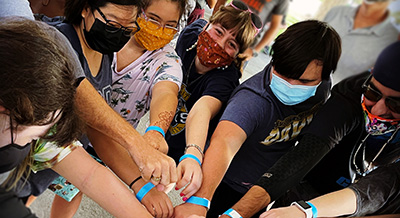California’s ‘red flag’ law utilized for 58 threatened mass shootings
 A VPRP study published this June examined case details and mortality records from the first three years of California’s GVRO or “red flag” law, which went into effect on January 1, 2016.
A VPRP study published this June examined case details and mortality records from the first three years of California’s GVRO or “red flag” law, which went into effect on January 1, 2016.
The law allows law enforcement, family and household members, some co-workers, employers and teachers to work with a judge to temporarily remove access to firearms and ammunition from people at significant risk of harming themselves or others.
“Extreme risk protection orders, or GVROs, offer a common sense, popular, and promising tool for firearm violence prevention,” said Pear, the study’s lead author. “The findings suggest GVROs are being used as intended — to remove firearms from individuals threatening to harm themselves, their intimate partners, co-workers, classmates or the general public.”
The research, published in Injury Prevention, shows:
- GVROs were used most often by law enforcement officers to prevent firearm assault and homicide. About 80% of GVROs were used in cases of threatened interpersonal violence.
- Mass shooting threats occurred in almost 30% (58 cases) of all GVROS during this period. Six cases involved minors, all of whom targeted schools.
- Among the individuals who had firearms temporarily removed with a restraining order, almost 30% had an assault-type weapon such as an AR or AK-style rifle.
- GVROs were also shown to potentially be effective in preventing self-harm, which was threatened in about 40% of the cases. No suicides occurred among individuals subject to the restraining orders.
Many acts of firearm violence are preceded by implicit or explicit threats, including two-thirds of public mass violence. Despite these warning signs, law enforcement officers in most states cannot remove firearms from individuals at risk of violence who aren’t already prohibited from possessing firearms. California’s GVRO law was created to fill this legal gap.
Additional authors: Wintemute, Rocco Pallin, Julia Schleimer, Elizabeth Tomsich, Kravitz-Wirtz, and Aaron Shev from VPRP, and Christopher Knoepke from the University of Colorado School of Medicine.
Machine learning identifies gun buyers at risk of suicide
 A first-of-its-kind VPRP study published in July suggests that machine learning, a type of artificial intelligence, may help identify handgun purchasers at high-risk of suicide. It also identified individual and community characteristics predictive of firearm suicide. The study was published in JAMA Network Open.
A first-of-its-kind VPRP study published in July suggests that machine learning, a type of artificial intelligence, may help identify handgun purchasers at high-risk of suicide. It also identified individual and community characteristics predictive of firearm suicide. The study was published in JAMA Network Open.
Almost 48,000 Americans died by suicide in 2020, of which more than 24,000 were firearm suicides. Previous research has shown the risk of suicide is particularly high immediately after purchase, suggesting that acquisition itself is an indicator of elevated suicide risk. Other risk factors identified by the machine learning algorithm to be predictive of firearm suicide included:
- older age
- first-time firearm purchaser
- white race
- living in close proximity to the gun dealer
- purchasing a revolver
“While limiting access to firearms among individuals at increased risk for suicide presents a critical opportunity to save lives, accurately identifying those at risk remains a key challenge,” said Hannah Laqueur, Ph.D., M.P.A., M.S., lead author of the study and an assistant professor in the Department of Emergency Medicine. “Our results suggest the potential utility of handgun records in identifying high-risk individuals to aid suicide prevention.”
To see if an algorithm could identify gun purchasers at risk of firearm suicide, researchers examined data from almost 5 million transactions from the California Dealer Record of Sale database — representing almost 2 million individuals — as well as California death records.
The researchers caution that the study was largely “proof of concept.” Still, the results suggest the potential of utilizing handgun records in identifying high-risk individuals to aid suicide prevention. They also noted that many firearm suicides occurred among individuals classified as “low-risk,” so other forms of intervention would be necessary in this group.
Additional authors: Colette Smirniotis, Christopher McCort and Wintemute.
New, free course to help health care providers reduce gun violence
 The BulletPoints Project at UC Davis Health has launched a free online continuing education course to help physicians and other health care providers reduce gun violence. Although it’s geared for clinicians, anyone can sign up.
The BulletPoints Project at UC Davis Health has launched a free online continuing education course to help physicians and other health care providers reduce gun violence. Although it’s geared for clinicians, anyone can sign up.
The training shows how to have conversations with patients who have access to firearms and may be at risk of interpersonal violence, suicide, or unintentional injury. It also teaches participants how to intervene according to the type and level of risk of firearm violence.
“Clinicians play an important role in shaping public perceptions about safety and injury prevention,” said Barnhorst, the BulletPoints director. “The same way a health care provider might ask a patient about smoking cigarettes, or a pediatrician might ask about car seats, they can also talk to their patients about firearms in a non-partisan, non-judgmental way.”
The course, “Preventing Firearm Injury: What Clinicians Can Do,” features different scenarios where a patient may be at risk of firearm violence, including suicide, dementia, intimate partner violence, mass shootings and unintentional injury. Clinicians are introduced to the “3A’s Framework” and are walked through scenarios while learning about how to apply the framework and intervention resources, as well as how to talk about risks and interventions in culturally and politically neutral ways.
The course takes about an hour, and can count for one Continuing Medical Education (CME) through the California Medical Association or one Continuing Education (CE) credit through the American Psychological Association. To earn credit, participants must complete all activities, pass a quiz, and complete an unscored evaluation.




